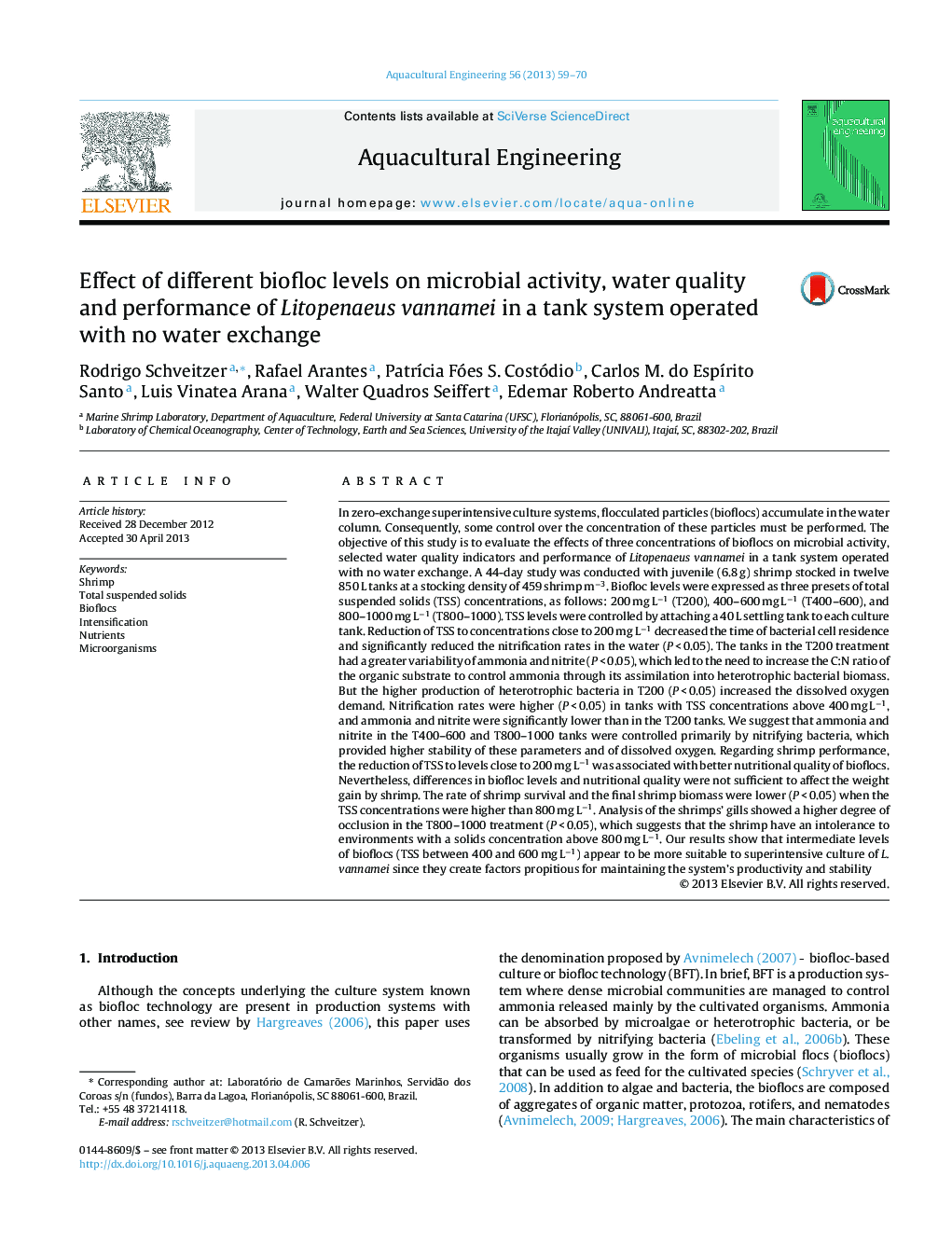| کد مقاله | کد نشریه | سال انتشار | مقاله انگلیسی | نسخه تمام متن |
|---|---|---|---|---|
| 4527237 | 1625714 | 2013 | 12 صفحه PDF | دانلود رایگان |

• We tested the effect of three concentrations of bioflocs in the culture of L. vannamei.
• The reduction of total suspended solids (TSS) to 200 mg L−1 decreased the nitrification rate.
• Nitrification rates were higher in tanks with TSS concentrations above 400 mg L−1.
• Shrimp survival and final biomass were lower when TSS is above 800 mg L−1.
• TSS in the range of 400 and 600 mg L−1 appear to be more suitable for culture of L. vannamei.
In zero-exchange superintensive culture systems, flocculated particles (bioflocs) accumulate in the water column. Consequently, some control over the concentration of these particles must be performed. The objective of this study is to evaluate the effects of three concentrations of bioflocs on microbial activity, selected water quality indicators and performance of Litopenaeus vannamei in a tank system operated with no water exchange. A 44-day study was conducted with juvenile (6.8 g) shrimp stocked in twelve 850 L tanks at a stocking density of 459 shrimp m−3. Biofloc levels were expressed as three presets of total suspended solids (TSS) concentrations, as follows: 200 mg L−1 (T200), 400–600 mg L−1 (T400–600), and 800–1000 mg L−1 (T800–1000). TSS levels were controlled by attaching a 40 L settling tank to each culture tank. Reduction of TSS to concentrations close to 200 mg L−1 decreased the time of bacterial cell residence and significantly reduced the nitrification rates in the water (P < 0.05). The tanks in the T200 treatment had a greater variability of ammonia and nitrite (P < 0.05), which led to the need to increase the C:N ratio of the organic substrate to control ammonia through its assimilation into heterotrophic bacterial biomass. But the higher production of heterotrophic bacteria in T200 (P < 0.05) increased the dissolved oxygen demand. Nitrification rates were higher (P < 0.05) in tanks with TSS concentrations above 400 mg L−1, and ammonia and nitrite were significantly lower than in the T200 tanks. We suggest that ammonia and nitrite in the T400–600 and T800–1000 tanks were controlled primarily by nitrifying bacteria, which provided higher stability of these parameters and of dissolved oxygen. Regarding shrimp performance, the reduction of TSS to levels close to 200 mg L−1 was associated with better nutritional quality of bioflocs. Nevertheless, differences in biofloc levels and nutritional quality were not sufficient to affect the weight gain by shrimp. The rate of shrimp survival and the final shrimp biomass were lower (P < 0.05) when the TSS concentrations were higher than 800 mg L−1. Analysis of the shrimps’ gills showed a higher degree of occlusion in the T800–1000 treatment (P < 0.05), which suggests that the shrimp have an intolerance to environments with a solids concentration above 800 mg L−1. Our results show that intermediate levels of bioflocs (TSS between 400 and 600 mg L−1) appear to be more suitable to superintensive culture of L. vannamei since they create factors propitious for maintaining the system’s productivity and stability
Journal: Aquacultural Engineering - Volume 56, September 2013, Pages 59–70